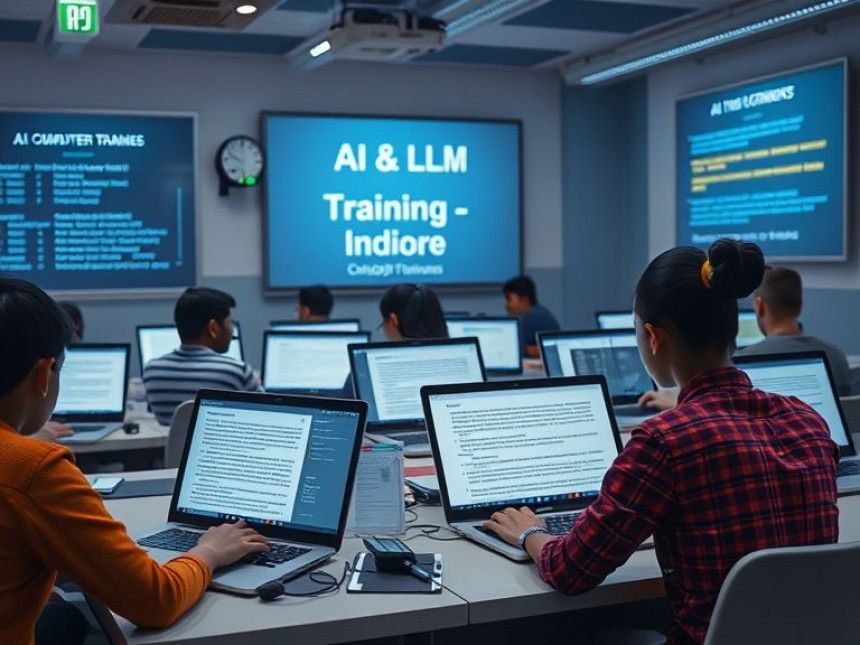
Step-by-Step: Use LLMs to Summarize Long Documents
Step-by-Step: Use LLMs to Summarize Long Documents. Get practical lessons and hands-on examples at AIComputerClasses in Indore to master artificial intelligence (AI) skills quickly. Includes references to tools like ChatGPT, Power BI, Excel, Figma, or Python where appropriate. Follow practical exercises and tool-based examples to learn rapidly. This article from AIComputerClasses Indore breaks down step-by-step: use llms to summarize long documents into actionable steps.
🧠 Step-by-Step: Use LLMs to Summarize Long DocumentsIn today’s information-driven world, handling large volumes of text efficiently is a key skill. Long documents — whether they’re reports, research papers, or transcripts — can be time-consuming to read and analyze. That’s where Large Language Models (LLMs) like ChatGPT come in!
In this guide from AI Computer Classes, Indore, we’ll walk through the practical steps to summarize long documents using LLMs, ensuring clarity, accuracy, and relevance.
An LLM (Large Language Model) is an advanced AI model trained on massive datasets to understand and generate human-like text. Examples include:
- ChatGPT (by OpenAI)
- Claude (by Anthropic)
- Gemini (by Google)
- LLaMA (by Meta)
These models can read, comprehend, and summarize long documents by identifying key ideas, eliminating redundancy, and generating human-quality summaries.
Summarization powered by LLMs can:
✅ Save hours of manual reading and note-taking
✅ Extract key insights from large datasets
✅ Improve content understanding for reports or research
✅ Generate concise summaries for blogs, meetings, or academic papers
At AI Computer Classes, Indore, we teach students how to use AI practically — including summarizing large texts efficiently with real tools and projects.
Before summarization, gather your document in a readable format — such as .txt, .pdf, or .docx.
If your file is too large, split it into smaller parts using Python or a text editor.
Example using Python:
# Split a long document into smaller parts
with open("document.txt", "r", encoding="utf-8") as file:
text = file.read()
# Break text into 2000-word chunks
chunks = [text[i:i+2000] for i in range(0, len(text), 2000)]
This ensures each part fits within an LLM’s token limit.
You can summarize documents interactively using ChatGPT or programmatically using OpenAI’s API.
🔹 Example using ChatGPT manually:Prompt:
“Summarize this document in 200 words. Focus on the main ideas and skip the minor details.”
Copy and paste sections of your document into ChatGPT.
from openai import OpenAI
client = OpenAI(api_key="YOUR_API_KEY")
with open("document.txt", "r") as f:
document_text = f.read()
response = client.chat.completions.create(
model="gpt-4o-mini",
messages=[
{"role": "system", "content": "You are a helpful assistant that summarizes text."},
{"role": "user", "content": f"Summarize this document:\n{document_text}"}
]
)
print(response.choices[0].message.content)
This script automatically generates a clean, concise summary from the document.
Once the summary is generated, it’s time to make it visually appealing and easy to understand.
Use Canva or Power BI to design:
- Summary cards
- Visual infographics of main points
- Key insights charts
This is especially useful for business reports or student projects.
Example formatting:
🔹 Title: Research on AI Trends 2025 🔹 Key Insights: - LLMs are transforming automation. - Ethical concerns are growing. - AI-driven productivity tools dominate global markets.🧠 Step 4: Automate Multi-Section Summaries
If your document has multiple chapters or topics, summarize each section individually.
Example Python loop:
summaries = []
for i, chunk in enumerate(chunks):
prompt = f"Summarize this section (Part {i+1}):\n{chunk}"
response = client.chat.completions.create(
model="gpt-4o-mini",
messages=[{"role": "user", "content": prompt}]
)
summaries.append(response.choices[0].message.content)
After summarizing all chunks, merge them into a final summary.
To ensure your summaries are reliable, check for:
✅ Accuracy — Do the main ideas match the original document?
✅ Coherence — Is the flow logical?
✅ Brevity — Is it concise yet complete?
✅ Tone — Does it fit your intended use (academic, business, etc.)?
💡 Tip: Tools like GPT-based evaluators or ROUGE score in NLP can help assess summary quality programmatically.
Now that you have a concise summary, you can:
- Post it on a blog or company website
- Turn it into a presentation using PowerPoint or Canva
- Feed it into Power BI dashboards for content insights
This bridges the gap between AI summarization and real-world presentation.
Here’s how professionals use LLM summarization daily:
Use CaseTool ExampleOutputResearch papersChatGPT / Claude500-word academic summaryBusiness reportsPower BI + GPTKey metrics & executive summaryEducationAIComputerClasses ProjectsStudent-friendly study notesSocial media contentCanva + GPTShort captions & highlights
🧭 Bonus: Summarizing PDFs in PythonYou can extract text from PDFs before summarization using PyPDF2:
import PyPDF2
pdf_file = open("report.pdf", "rb")
reader = PyPDF2.PdfReader(pdf_file)
text = ""
for page in reader.pages:
text += page.extract_text()
print("PDF text extracted!")
Then send the text to an LLM for summarization using the same API method.
At AI Computer Classes, Indore, students learn hands-on AI applications such as:
- Text summarization using LLMs
- Sentiment analysis
- Chatbot development
- Data-driven AI projects
Every lesson includes tool-based learning using ChatGPT, Python, and Power BI to ensure you gain both technical and practical skills.
🚀 Start your journey with us today and build real-world AI solutions!
🧭 ConclusionSummarizing long documents manually is time-consuming — but with LLMs, it becomes efficient, accurate, and customizable. Whether you’re a student, data analyst, or content creator, this skill is essential in today’s AI-powered landscape.
From data extraction to visualization, combining tools like ChatGPT, Python, and Canva empowers you to turn lengthy information into meaningful insights.





